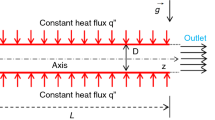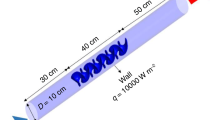Abstract
Heat transfer enhancement is an important issue because of environmental effects and also cost reduction in any thermal installation. A combined propeller-type turbulator and Al2O3 nanofluid are considered for heat transfer enhancement in a horizontal circular tube. Three-dimensional governing equations using the two-phase mixture model with SST k–ε turbulent model are numerically solved to predict the behavior of different thermo-fluid parameters in a horizontal circular tube. In addition to studying the effects of these, both means on the heat transfer enhancement, an important discussion on their simultaneous effects are also presented. The effects of turbulator on the generation of swirl flow and also on the turbulent kinetic energy are shown and discussed for different nanoparticle volume fractions and different nanoparticle mean diameters. On one hand, the effect of inserting a turbulator on the thermal performance significantly dominates the effect of using a nanofluid. For instance, at the Z/D = 13.5, using combined nanofluid and turbulator the heat transfer coefficient 2.68 times augments while using only a turbulator it is 2.53 times enhanced. On the other hand, turbulator generates a radial gradient on the momentum forces. The latter significantly deteriorates the uniformity of the nanoparticles concentration. A higher nanoparticle concentration at the near-wall region where the sedimentation problem is taken placed is seen. Thus, it is recommended that nanofluid is not a suitable choice for simultaneous consideration with a propeller-type turbulator in such an application particularly when considering its physicochemical stability drawback. However, further experimental investigations must be carried out to verify such a conclusion and recommendation. It should be mentioned that agglomeration and sedimentation of nanoparticles on the wall surface have not been considered on the modeling of nanofluid physical properties.











Similar content being viewed by others
Abbreviations
- a :
-
Acceleration
- C f :
-
Skin friction coefficient (= τw/0.5 ρ V2in)
- C p :
-
Specific heat (J kg−1 K−1)
- D, d :
-
Diameter (m)
- g :
-
Acceleration of gravity (ms−2)
- h :
-
Convective heat transfer coefficient (Wm2 K−1), Enthalpy (J kg−1)
- k :
-
Turbulent kinetic energy (m2 s2)
- Nu :
-
Nusselt number (= hD/λ)
- Pr :
-
Pandtl number (= μCp/λ)
- R, r :
-
Tube radius (m)
- Re :
-
Reynolds number (= VD/υ)
- S :
-
Swirl number
- T :
-
Temperature (K)
- V :
-
Velocity (ms−1)
- Z :
-
Axial coordinate (m)
- α :
-
Diffusion coefficient (m2 s−1)
- ϕ :
-
Volume fraction
- δ :
-
Boundary layer thickness (nm)
- ξ :
-
Vorticity magnitude (= ∇ × V)
- ρ :
-
Density (kg m−3)
- μ :
-
Dynamic viscosity (Nsm−2)
- υ :
-
Kinematic viscosity (m2 s−1)
- θ :
-
Vane angle of turbulator
- τ :
-
Shear stress (Nm−2)
- λ :
-
Thermal conductivity (Wm−1 K−1)
- ω :
-
Turbulent kinetic energy dissipation
- ax:
-
Axial
- c:
-
Central
- f:
-
Primary phase
- k:
-
The kth phase
- in:
-
Inlet
- m:
-
Mixture
- p:
-
Particle, secondary phase
- t:
-
Turbulent
- w:
-
Wall
References
Bergles AE. Techniques to Augment Heat Transfer. Handbook of Heat Transfer 74-17085 05-33. New York: McGraw-Hill; 1973.
Liu S, Sakr M. A comprehensive review on passive heat transfer enhancements in pipe exchangers. Renew. Sustain. Energy Rev. 2013;19:64–81.
Sheikholeslami M, Gorji-Bandpy M, Ganji DD. Review of heat transfer enhancement methods: focus on passive methods using swirl flow devices. Renew. Sustain. Energy Rev. 2015;49:444–69.
Bhattacharyya S, Saha S, Saha SK. Laminar flow heat transfer enhancement in a circular tube having integral transverse rib roughness and fitted with centre-cleared twisted-tape. Exp. Therm. Fluid Sci. 2013;44:727–35.
Saha SK, Bhattacharyya S, Pal PK. Thermohydraulics of laminar flow of viscous oil through a circular tube having integral axial rib roughness and fitted with center-cleared twisted-tape. Exp. Therm. Fluid Sci. 2012;41:121–9.
Bhattacharyya S, Saha SK. Thermohydraulics of laminar flow through a circular tube having integral helical rib roughness and fitted with centre-cleared twisted-tape. Exp. Therm. Fluid Sci. 2012;42:154–62.
Bali T. Modelling of heat transfer and fluid flow for decaying swirl flow in a circular pipe. Int. Commun. Heat Mass Transf. 1998;25:349–58.
Durmuş A, Kurbaş I, Gulçimen F, Turgut E. Investigation of the effect of co-axis free rotating propeller-type turbulators on the performance of heat exchanger. Int. Commun. Heat Mass Transf. 2004;31:133–42.
Kurtbaş I, Durmuş A, Eren H, Turgut E. Effect of propeller type swirl generators on the entropy generation and efficiency of heat exchangers. Int. J. Therm. Sci. 2007;46:300–7.
Saraç BA, Bali T. An experimental study on heat transfer and pressure drop characteristics of decaying swirl flow through a circular pipe with a vortex generator. Exp. Therm. Fluid Sci. 2007;32:158–65.
Bali T, Saraç B. Exergy analysis of heat transfer in a turbulent pipe flow by a decaying swirl generator. Int. J. Exergy. 2008;5:64–77.
Eiamsa-ard S, Rattanawong S, Promvonge P. Turbulent convection in round tube equipped with propeller type swirl generators. Int. Commun. Heat Mass Transf. 2009;36:357–64.
Khalil A, Zohir A, Farid A. Heat transfer characteristics and friction of turbulent swirling air flow through abrupt expansion. Am. J. Sci. Ind. Res. 2010;1:364–74.
Ahmadvand M, Najafi AF, Shahidinejad S. An experimental study and CFD analysis towards heat transfer and fluid flow characteristics of decaying swirl pipe flow generated by axial vanes. Meccanica. 2010;45:111–29.
Yang CS, Jeng DZ, Yang YJ, Chen R, Gau C. Experimental study of pre-swirl flow effect on the heat transfer process in the entry region of a convergent pipe. Exp. Therm. Fluid Sci. 2011;35:73–81.
Duangthongsuk W, Wongwises S. An experimental investigation of the heat transfer and pressure drop characteristics of a circular tube fitted with rotating turbine-type swirl generators. Exp. Therm. Fluid Sci. 2013;45:8–15.
Bali T, Saraç BA. Experimental investigation of decaying swirl flow through a circular pipe for binary combination of vortex generators. Int. Commun. Heat Mass Transf. 2014;53:174–9.
Rocha AD, Bannwart AC, Ganzarolli MM. Numerical and experimental study of an axially induced swirling pipe flow. Int. J. Heat Fluid Flow. 2015;53:81–90.
Chai L, Tassou SA. A review of air side heat transfer augmentation with vortex generators on heat transfer surface. Energies. 2018;11:2737.
Choi SUS, Eastman JA. Enhancing thermal conductivity of fluids with nanoparticles. ASME Int Mech Eng Congr Expos 1995;66:99–105.
Osman S, Sharifpur M, Meyer JP. Experimental investigation of convection heat transfer in the transition flow regime of aluminium oxide-water nanofluids in a rectangular channel. Int. J. Heat Mass Transf. 2019;133:895–902.
Sharifpur M, Solomon AB, Ottermann TO, Meyer JP. Optimum concentration of nanofluids for heat transfer enhancement under cavity flow natural convection with TiO2–Water. Int. Commun. Heat Mass Transf. 2018;98:297–303.
Behzadmehr A, Saffar-Avval M, Galanis N. Prediction of turbulent forced convection of a nanofluid in a tube with uniform heat flux using a two phase approach. Int. J. Heat Fluid Flow. 2007;28:211–9.
Onyiriuka EJ, Obanor AI, Mahdavi M, Ewim DRE. Evaluation of single-phase, discrete, mixture and combined model of discrete and mixture phases in predicting nanofluid heat transfer characteristics for laminar and turbulent flow regimes. Adv. Powder Technol. 2018;29:2644–57.
Aybar HŞ, Sharifpur M, Azizian MR, Mehrabi M, Meyer JP. A review of thermal conductivity models for nanofluids. Heat Transf. Eng. 2015;36:1085–110.
Masoumi N, Sohrabi N, Behzadmehr A. A new model for calculating the effective viscosity of nanofluids. J. Phys. D Appl. Phys. 2009;42:55501.
Mahdavi M, Sharifpur M, Meyer JP. Discrete modelling of nanoparticles in mixed convection flows. Powder Technol. 2018;338:243–52.
Mahdavi M, Garbadeen I, Sharifpur M, Ahmadi MH, Meyer JP. Study of particle migration and deposition in mixed convective pipe flow of nanofluids at different inclination angles. J. Therm. Anal. Calorim. 2019;135:1563–75.
Farzaneh H, Behzadmehr A, Yaghoubi M, Samimi A, Sarvari SMH. Stability of nanofluids: molecular dynamic approach and experimental study. Energy Convers. Manag. 2016;111:1–14.
Safikhani H, Hajian E, Mohammadi R. Numerical simulation of nanofluid flow over diamond-shaped elements in tandem in laminar and turbulent flow. Transp. Phenom. Nano Micro Scales. 2017;5:102–10.
Eiamsa-ard S, Wongcharee K. Experimental study of TiO2–water nanofluid flow in corrugated tubes mounted with semi-circular wing tapes. Heat Transf. Eng. 2018;39:1–14.
Sheikholeslami M, Jafaryar M, Li Z. Nanofluid turbulent convective flow in a circular duct with helical turbulators considering CuO nanoparticles. Int. J. Heat Mass Transf. 2018;124:980–9.
Rashidi S, Eskandarian M, Mahian O, Poncet S. Combination of nanofluid and inserts for heat transfer enhancement Gaps and challenges. J. Therm. Anal. Calorim. 2019;135:437–60.
Manninen M, Taivassalo V, Kallio S. On the Mixture Model for Multiphase Flow. New York: VTT Publications; 1996. p. 1–67.
Schiller L, Naumann Z. A drag coefficient correlation. Vdi Zeitung. 1935;77:51.
Menter FR. Two-equation eddy-viscosity turbulence models for engineering applications. AIAA J. 1994;32:1598–605.
Xuan Y, Roetzel W. Conceptions for heat transfer correlation of nanofluids. Int. J. Heat Mass Transf. 2000;43:3701–7.
Chon CH, Kihm KD, Lee SP, Choi SUS. Empirical correlation finding the role of temperature and particle size for nanofluid (Al2O3) thermal conductivity enhancement. Appl. Phys. Lett. 2005;87:153107-1–3.
Gnielinski V. New equations for heat and mass transfer in turbulent pipe and channel flow. Int. Chem. Eng. 1976;16:359–68.
Author information
Authors and Affiliations
Corresponding author
Ethics declarations
Conflict of interest
The authors declare that there is no conflict of interest.
Additional information
Publisher's Note
Springer Nature remains neutral with regard to jurisdictional claims in published maps and institutional affiliations.
Rights and permissions
About this article
Cite this article
Nikoozadeh, A., Behzadmehr, A. & Payan, S. Numerical investigation of turbulent heat transfer enhancement using combined propeller-type turbulator and nanofluid in a circular tube. J Therm Anal Calorim 140, 1029–1044 (2020). https://doi.org/10.1007/s10973-019-08578-x
Received:
Accepted:
Published:
Issue Date:
DOI: https://doi.org/10.1007/s10973-019-08578-x




